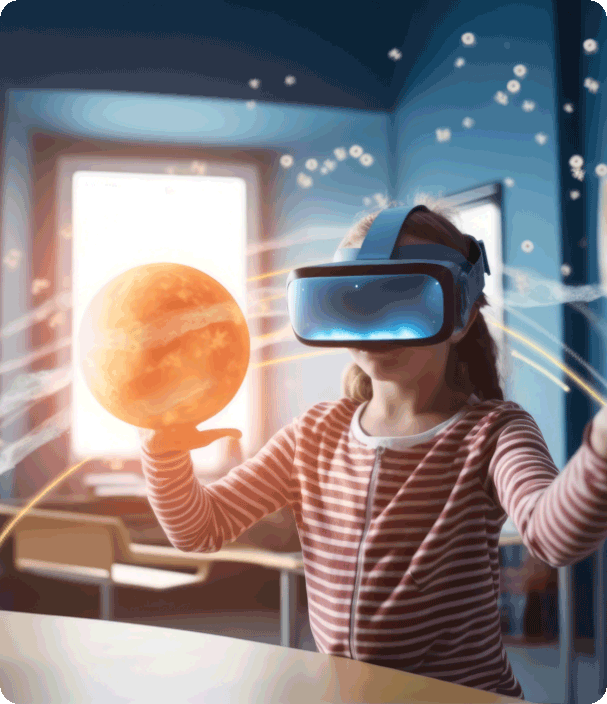
The transformation that traditional education needs, in the era of human enhancement.
As readers might already know,Augmented Reality (AR) and Virtual Reality (VR) are immersive technologies that can create realistic and interactive simulations of real or imaginary environments. AR overlays digital information on the physical world, while VR transports the user to a fully digital world. Both technologies have enormous potential to transform the way we learn and teach, especially in the era of human enhancement.
But first, what is human enhancement? It’s the natural, artificial, or technological alteration of the human body to enhance physical or mental capabilities. Various technologies are being used to make humans smarter than before and solve some long-standing problems. Some of these technologies – in various stages of completion – are genetic engineering, neurotechnology, cyberware, nanomedicine, and 3D bioprinting.
As history and recent events have shown us, development is not going to wait till we answer all questions. Historically, education has lagged behind in addressing the effects of technology. A good example of this is how some schools around the world teach students how to live in an age of social media and misinformation. Hence, it’s important we prepare our students (and ourselves!) for a future where some may have augmented abilities and others might not. While this is an unavoidable shift – more schools and colleges are adopting AR/VR technologies – it is important that acceptance is faster, or else there will be a disparity.
A massively profound shift.
Augmenting education in an ‘enhanced’ era
We need to ensure that education is inclusive, ethical, and beneficial for all. This becomes all the more important as human enhancement becomes more widespread and accessible. Traditional education models may not be adequate or relevant for the challenges and opportunities that enhanced humans will face. We need to transform education to suit the needs and aspirations of enhanced humans, as well as those who choose not to enhance themselves.
One possible way to transform education in this new paradigm is to adopt an AR/VR-based curriculum. As you might have gathered, it’s a curriculum that uses these technologies as integral tools for learning and teaching. It can offer several advantages and could even transform the future of education itself. Here are some benefits we foresee:
- Providing Immersive Learning Experiences: AR and VR technologies offer immersive learning experiences that go beyond the traditional classroom setting. Through AR, students can overlay digital information onto the real world, enhancing their understanding and engagement. VR, on the other hand, creates virtual environments that simulate real-life scenarios, allowing students to explore, experiment, and interact with content. These immersive experiences make learning more dynamic, captivating, and effective.
- Visualizing Complex Concepts: Students will be able to visualize (and not just imagine) complex concepts that might be challenging to grasp. Abstract ideas in science, engineering, mathematics and medicine can be brought to life with 3D models and interactive simulations. Students can manipulate objects, observe dynamic processes, and gain a deeper understanding of intricate concepts. As the saying goes – you retain more if you actually do something, and this approach takes us one step closer to enhanced comprehension and retention.
- Opening up Opportunities for Collaborative Learning: The connectivity aspect of AR and VR will mean that students will be able to engage in virtual environments. Here, they can collaborate, communicate, and solve problems together, regardless of physical distance. They can work on group projects, participate in virtual simulations, and share knowledge and ideas in real-time. Collaborative learning nurtures teamwork, communication skills, and the ability to work in diverse and global contexts.
- Enhancing Practical Training: Certain fields, such as healthcare, engineering, and vocational training, require hands-on practical experience. AR and VR can provide virtual practice environments where students can develop and refine their skills without the need for expensive equipment or facing real-life risks. Medical students can simulate surgeries, engineering students can design and test structures, and vocational students can practice technical tasks. This immersive practical training prepares students for real-world challenges better than even the best textbook could.
- Engaging and Motivating Students: AR and VR-based curricula captivate students’ attention by offering interactive and engaging learning experiences. The novelty and excitement of these technologies motivate students to explore and participate actively in their education. Gamification elements can be incorporated, turning learning into an enjoyable and rewarding experience. By making learning more enjoyable, AR and VR foster a love for lifelong learning and spark curiosity in students.
- Offering Personalized and Adaptive Learning: These curricula can be tailored to individual learning styles and preferences, promoting personalized and adaptive learning experiences. Students can learn at their own pace, exploring topics that interest them the most. AR and VR applications can adapt to students’ progress, providing targeted feedback and additional support when needed. This personalized approach fosters student engagement, motivation, and ultimately, better learning outcomes.
In conclusion
As we witness the transformation of humans into enhanced beings, traditional education needs to keep pace with the changing times to ensure there is parity in education and nobody has an unfair advantage. With all the benefits mentioned above, AR and VR technologies present a remarkable opportunity to revolutionize education, transforming it into enhanced education. Now is the time to embrace these technologies and harness their full potential to create a dynamic and impactful learning environment for the next generation of learners.
Want to know more and engage with us?
Reach us at sales@brahmarsive.com
Our News
See Our Latest & Popular News.
Enhancing Education: Why NOW is the time for AR/VR-based curriculam
Enhancing Education: Why NOW is the time for AR/VR-based curriculam...
How Virtual Reality will Transform Healthcare
How Virtual Reality will Transform Healthcare How Virtual Reality will...
Elevate Aircraft Maintenance Training with AR/VR: A Gamified Future
Elevate Aircraft Maintenance Training with AR/VR: A Gamified Future Elevate...

